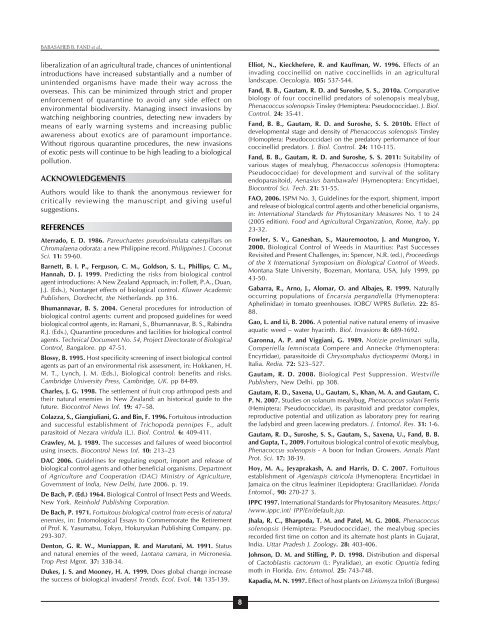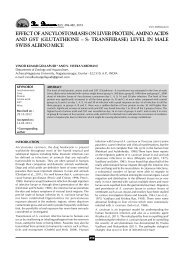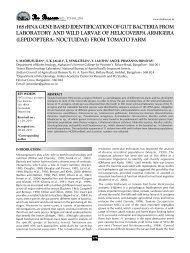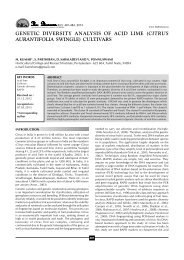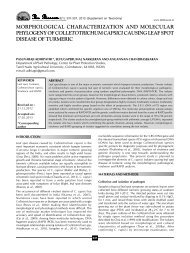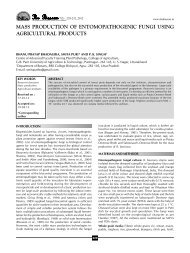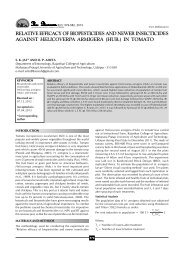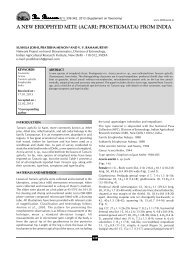Fortuitous biological control of insect pests and ... - THE BIOSCAN
Fortuitous biological control of insect pests and ... - THE BIOSCAN
Fortuitous biological control of insect pests and ... - THE BIOSCAN
- No tags were found...
You also want an ePaper? Increase the reach of your titles
YUMPU automatically turns print PDFs into web optimized ePapers that Google loves.
BABASAHEB B. FAND et al.,liberalization <strong>of</strong> an agricultural trade, chances <strong>of</strong> unintentionalintroductions have increased substantially <strong>and</strong> a number <strong>of</strong>unintended organisms have made their way across theoverseas. This can be minimized through strict <strong>and</strong> properenforcement <strong>of</strong> quarantine to avoid any side effect onenvironmental biodiversity. Managing <strong>insect</strong> invasions bywatching neighboring countries, detecting new invaders bymeans <strong>of</strong> early warning systems <strong>and</strong> increasing publicawareness about exotics are <strong>of</strong> paramount importance.Without rigorous quarantine procedures, the new invasions<strong>of</strong> exotic <strong>pests</strong> will continue to be high leading to a <strong>biological</strong>pollution.ACKNOWLEDGEMENTSAuthors would like to thank the anonymous reviewer forcritically reviewing the manuscript <strong>and</strong> giving usefulsuggestions.REFERENCESAterrado, E. D. 1986. Pareuchaetes pseudoinsulata caterpillars onChromalaena odorata: a new Philippine record. Philippines J. CoconutSci. 11: 59-60.Barnett, B. I. P., Ferguson, C. M., Goldson, S. L., Phillips, C. M.,Hannah, D. J. 1999. Predicting the risks from <strong>biological</strong> <strong>control</strong>agent introductions: A New Zeal<strong>and</strong> Approach, in: Follett, P.A., Duan,J.J. (Eds.), Nontarget effects <strong>of</strong> <strong>biological</strong> <strong>control</strong>. Kluwer AcademicPublishers, Dordrecht, the Netherl<strong>and</strong>s. pp 316.Bhumannavar, B. S. 2004. General procedures for introduction <strong>of</strong><strong>biological</strong> <strong>control</strong> agents: current <strong>and</strong> proposed guidelines for weed<strong>biological</strong> <strong>control</strong> agents, in: Ramani, S., Bhumannavar, B. S., RabindraR.J. (Eds.), Quarantine procedures <strong>and</strong> facilities for <strong>biological</strong> <strong>control</strong>agents. Technical Document No. 54, Project Directorate <strong>of</strong> BiologicalControl, Bangalore. pp 47-51.Blossy, B. 1995. Host specificity screening <strong>of</strong> <strong>insect</strong> <strong>biological</strong> <strong>control</strong>agents as part <strong>of</strong> an environmental risk assessment, in: Hokkanen, H.M. T., Lynch, J. M. (Eds.), Biological <strong>control</strong>: benefits <strong>and</strong> risks.Cambridge University Press, Cambridge, UK. pp 84-89.Charles, J. G. 1998. The settlement <strong>of</strong> fruit crop arthropod <strong>pests</strong> <strong>and</strong>their natural enemies in New Zeal<strong>and</strong>: an historical guide to thefuture. Bio<strong>control</strong> News Inf. 19: 47–58.Colazza, S., Giangiuliani, G. <strong>and</strong> Bin, F. 1996. <strong>Fortuitous</strong> introduction<strong>and</strong> successful establishment <strong>of</strong> Trichopoda pennipes F., adultparasitoid <strong>of</strong> Nezara viridula (L.). Biol. Control. 6: 409-411.Crawley, M. J. 1989. The successes <strong>and</strong> failures <strong>of</strong> weed bio<strong>control</strong>using <strong>insect</strong>s. Bio<strong>control</strong> News Inf. 10: 213–23DAC 2006. Guidelines for regulating export, import <strong>and</strong> release <strong>of</strong><strong>biological</strong> <strong>control</strong> agents <strong>and</strong> other beneficial organisms. Department<strong>of</strong> Agriculture <strong>and</strong> Cooperation (DAC) Ministry <strong>of</strong> Agriculture,Government <strong>of</strong> India, New Delhi, June 2006. p. 19.De Bach, P. (Ed.) 1964. Biological Control <strong>of</strong> Insect Pests <strong>and</strong> Weeds.New York. Reinhold Publishing Corporation.De Bach, P. 1971. <strong>Fortuitous</strong> <strong>biological</strong> <strong>control</strong> from ecesis <strong>of</strong> naturalenemies, in: Entomological Essays to Commemorate the Retirement<strong>of</strong> Pr<strong>of</strong>. K. Yasumatsu, Tokyo, Hokuryukan Publishing Company. pp.293-307.Denton, G. R. W., Muniappan, R. <strong>and</strong> Marutani, M. 1991. Status<strong>and</strong> natural enemies <strong>of</strong> the weed, Lantana camara, in Micronesia.Trop Pest Mgmt. 37: 338-34.Dukes, J. S. <strong>and</strong> Mooney, H. A. 1999. Does global change increasethe success <strong>of</strong> <strong>biological</strong> invaders? Trends. Ecol. Evol. 14: 135-139.Elliot, N., Kieckhefere, R. <strong>and</strong> Kauffman, W. 1996. Effects <strong>of</strong> aninvading coccinellid on native coccinellids in an agriculturall<strong>and</strong>scape. Oecologia. 105: 537-544.F<strong>and</strong>, B. B., Gautam, R. D. <strong>and</strong> Suroshe, S. S., 2010a. Comparativebiology <strong>of</strong> four coccinellid predators <strong>of</strong> solenopsis mealybug,Phenacoccus solenopsis Tinsley (Hemiptera: Pseudococcidae). J. Biol.Control. 24: 35-41.F<strong>and</strong>, B. B., Gautam, R. D. <strong>and</strong> Suroshe, S. S. 2010b. Effect <strong>of</strong>developmental stage <strong>and</strong> density <strong>of</strong> Phenacoccus solenopsis Tinsley(Homoptera: Pseudococcidae) on the predatory performance <strong>of</strong> fourcoccinellid predators. J. Biol. Control. 24: 110-115.F<strong>and</strong>, B. B., Gautam, R. D. <strong>and</strong> Suroshe, S. S. 2011: Suitability <strong>of</strong>various stages <strong>of</strong> mealybug, Phenacoccus solenopsis (Homoptera:Pseudococcidae) for development <strong>and</strong> survival <strong>of</strong> the solitaryendoparasitoid, Aenasius bambawalei (Hymenoptera: Encyrtidae),Bio<strong>control</strong> Sci. Tech. 21: 51-55.FAO, 2006. ISPM No. 3, Guidelines for the export, shipment, import<strong>and</strong> release <strong>of</strong> <strong>biological</strong> <strong>control</strong> agents <strong>and</strong> other beneficial organisms,in: International St<strong>and</strong>ards for Phytosanitary Measures No. 1 to 24(2005 edition). Food <strong>and</strong> Agricultural Organization, Rome, Italy. pp23-32.Fowler, S. V., Ganeshan, S., Mauremootoo, J. <strong>and</strong> Mungroo, Y.2000. Biological Control <strong>of</strong> Weeds in Mauritius: Past SuccessesRevisited <strong>and</strong> Present Challenges, in: Spencer, N.R. (ed.), Proceedings<strong>of</strong> the X International Symposium on Biological Control <strong>of</strong> Weeds.Montana State University, Bozeman, Montana, USA, July 1999, pp43-50.Gabarra, R., Arno, J., Alomar, O. <strong>and</strong> Albajes, R. 1999. Naturallyoccurring populations <strong>of</strong> Encarsia perg<strong>and</strong>iella (Hymenoptera:Aphelinidae) in tomato greenhouses. IOBC/ WPRS Bulletin. 22: 85-88.Gao, L. <strong>and</strong> Li, B. 2006. A potential native natural enemy <strong>of</strong> invasiveaquatic weed – water hyacinth. Biol. Invasions 8: 689-1692.Garonna, A. P. <strong>and</strong> Viggiani, G. 1989. Notizie preliminari sulla,Comperiella lemniscata Compere <strong>and</strong> Annecke (Hymenoptera:Encyrtidae), parassitoide di Chrysomphalus dyctiospermi (Morg.) inItalia. Redia. 72: 523–527.Gautam, R. D. 2008. Biological Pest Suppression. WestvillePublishers, New Delhi. pp 308.Gautam, R. D., Saxena, U., Gautam, S., Khan, M. A. <strong>and</strong> Gautam, C.P. N. 2007. Studies on solanum mealybug, Phenacoccus solani Ferris(Hemiptera: Pseudococcidae), its parasitoid <strong>and</strong> predator complex,reproductive potential <strong>and</strong> utilization as laboratory prey for rearingthe ladybird <strong>and</strong> green lacewing predators. J. Entomol. Res. 31: 1-6.Gautam, R. D., Suroshe, S. S., Gautam, S., Saxena, U., F<strong>and</strong>, B. B.<strong>and</strong> Gupta, T., 2009. <strong>Fortuitous</strong> <strong>biological</strong> <strong>control</strong> <strong>of</strong> exotic mealybug,Phenacoccus solenopsis - A boon for Indian Growers. Annals PlantProt. Sci. 17: 38-39.Hoy, M. A., Jeyaprakash, A. <strong>and</strong> Harris, D. C. 2007. <strong>Fortuitous</strong>establishment <strong>of</strong> Ageniaspis citricola (Hymenoptera: Encyrtidae) inJamaica on the citrus leafminer (Lepidoptera: Gracillariidae). FloridaEntomol., 90: 270-27 3.IPPC 1997. International St<strong>and</strong>ards for Phytosanitory Measures. https://www.ippc.int/ IPP/En/default.jsp.Jhala, R. C., Bharpoda, T. M. <strong>and</strong> Patel, M. G. 2008. Phenacoccussolenopsis (Hemiptera: Pseudococcidae), the mealybug speciesrecorded first time on cotton <strong>and</strong> its alternate host plants in Gujarat,India. Uttar Pradesh J. Zoology. 28: 403-406.Johnson, D. M. <strong>and</strong> Stilling, P. D. 1998. Distribution <strong>and</strong> dispersal<strong>of</strong> Cactoblastis cactorum (L: Pyralidae), an exotic Opuntia fedingmoth in Florida. Env. Entomol. 25: 743-748.Kapadia, M. N. 1997. Effect <strong>of</strong> host plants on Liriomyza trifoli (Burgess)8


